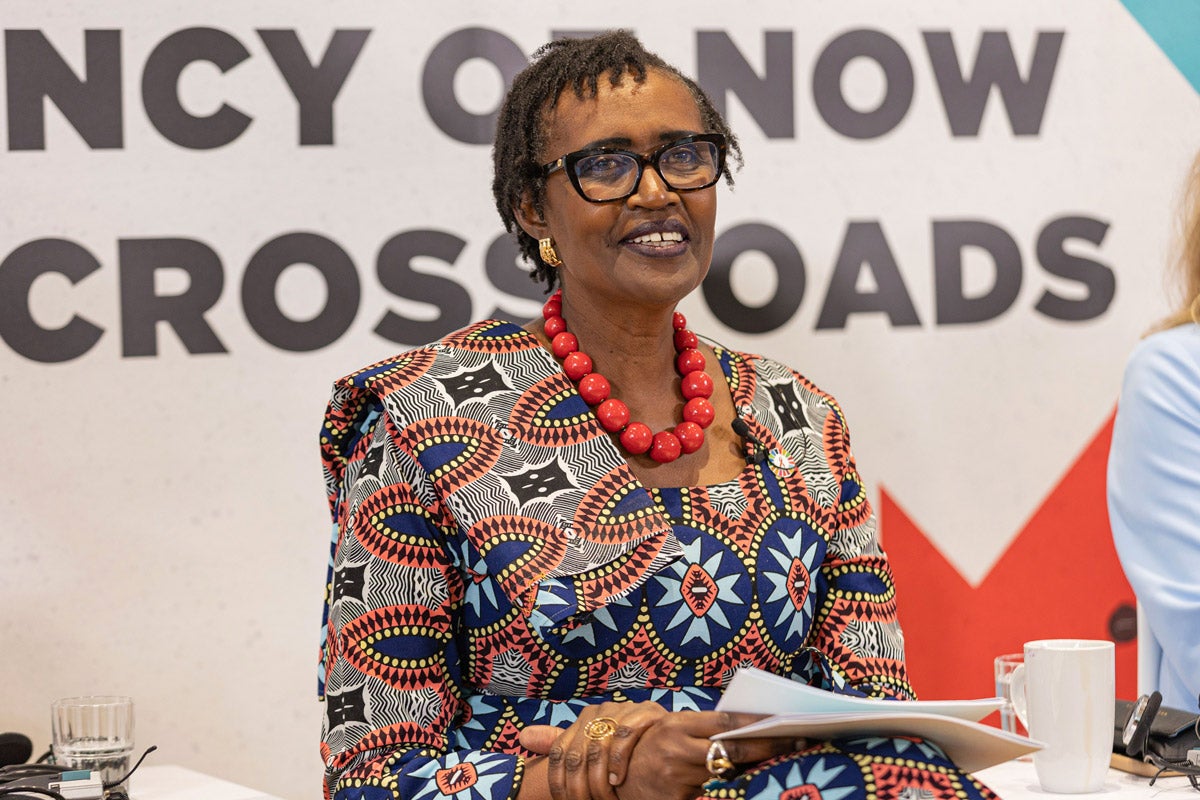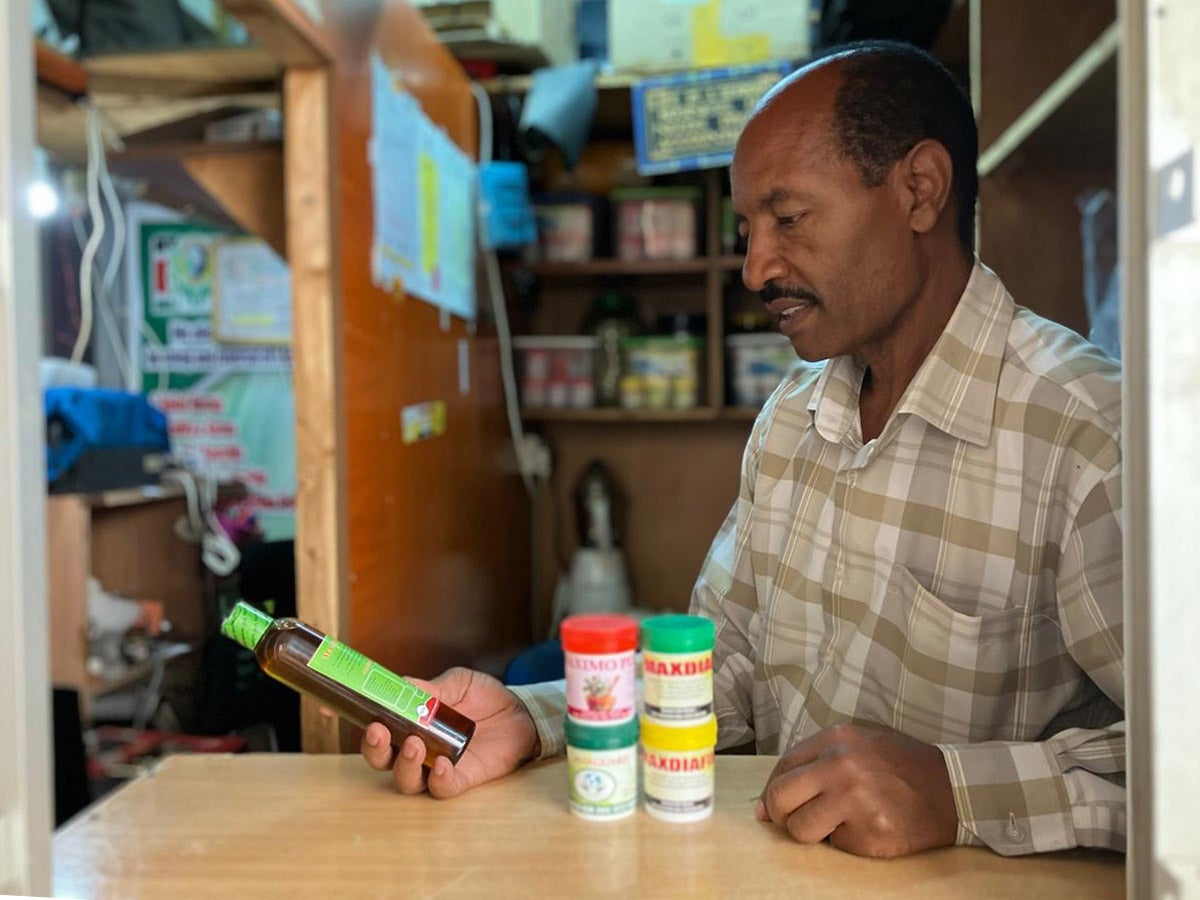
Feature
What’s working in the 19 countries on track to help end AIDS
The Joint United Nations Programme on HIV/AIDS (UNAIDS) has a code: 95-95-95.
That is the shorthand for an ambitious goal: By 2025, ninety-five percent of people in the world who are living with HIV should know their status; ninety-five percent of those people should be enrolled in anti-retroviral treatment; and ninety-five percent of those enrolled should achieve viral suppression, which means the virus is undetectable.
The targets were adopted by UN member states in 2021 to create momentum and milestones for ending the global AIDS crisis by 2030—which is, remarkably, a goal within reach. Because it is virtually impossible for people with undetectable levels of HIV to transmit the virus, reaching those targets would, effectively, end the transmission of the disease.
UNAIDS actually introduced its first targets for ending to the epidemic a decade ago. Those goals were lower—and, global health experts thought, ambitious. Yet nine countries have already reached the more demanding 95-95-95 target—Botswana, Denmark, Eswatini, Kenya, Malawi, Rwanda, Saudi Arabia, Zambia, and Zimbabwe—and ten more are on track to meet next year’s deadline.
Sign up for Harvard Public Health
Delivered to your inbox weekly.
Tendayi Westerhof, a health activist in Zimbabwe, says good policy management put Zimbabwe ahead. “Everyone who is working on HIV/AIDS has to fit into the national strategy,” she says, “which is derived from the targets.”
But she warns there are many challenges to achieving the milestone—challenges that extend well beyond Zimbabwe.
From the outset, global health architects were concerned about whether the health systems most impacted by HIV had the capacity to provide testing and treatment at the scale required. These worries became more acute as officials recognized that, due to stigma, they could not rely on people to just show up at health facilities for HIV testing and treatment.
The stigma is particularly detrimental for people in communities that are already marginalized—and sometimes criminalized. Those communities include sex workers, men who have sex with men (MSM), and people who inject drugs. These are often the same people most at risk for contracting HIV. Discrimination against these communities is sometimes buttressed by laws and policies, including some that criminalize homosexuality or sex work. Yet ensuring their access to services is crucial to reaching 95-95-95 in most countries, says Mary Mahy, who heads the collection and analysis of data at UNAIDS.
Around the world, officials have also learned to innovate and closely track the outcomes of the services they deliver—including testing and adherence, among the metrics—to ensure they are taking best advantage of finite funding.
Though each country’s path to 95-95-95 will be unique, the experiences of successful countries offer lessons for those that have fallen behind. Here are three solutions that have been particularly instrumental in getting and keeping people on treatment:
Community health workers
Botswana, which realized the 95-95-95 targets in 2022, began with an effort to combat the stigma around HIV, according to Peter Chibatamoto, the projects coordinator of Humana People to People Botswana, a grassroots program that aims to make HIV services more accessible.
Speaking on the sidelines of the 2024 International AIDS Conference in Munich, Germany, Chibatamoto says it became clear early in HPP’s efforts that fear and misunderstanding about the disease left people reluctant to use HIV services no matter how easy his organization made it. People did not trust health workers who tried to convince them they should know their status and, if they were infected, initiate treatment.
“There were so many people who would not want to go there,” he says—until the government enlisted local residents as community health workers (CHWs) who delivered basic services and connected people to the health system. Because CHWs know the local culture and have relationships with the people they serve, they are inherently trusted. This helps demystify the disease and encourages people to get tested and, if necessary, start treatment, Chibatamoto says.
In Cambodia, CHWs are called “lay counselors,” and they have been crucial to the country’s progress, says Vichea Ouk, the director of the National Center for HIV/AIDS, Dermatology and STDs in Phnom Penh. Cambodia has surpassed the targets for treatment and for viral suppression, and Ouk is hopeful the country will reach the testing target by the deadline. Teams that include people living with HIV work at health clinics, where they help dispel misconceptions about the virus and smooth people’s interactions with the health system.
In the past, a newly diagnosed patient might be overwhelmed by the glut of information, including details about when to pick up their medicines. The lay counselors follow up to make sure people show up for those appointments and absorb the importance of adhering to their daily treatment regimen.

Winnie Byanyima, executive director of UNAIDS and an undersecretary general of the United Nations, at the press conference at the 2024 International AIDS Conference in Munich, Germany in July.
Alexander Pohl / Sipa USA / Sipa via AP Images
Care outside of the clinic
Lloyd Mulenga is the head of infectious diseases at the national health ministry in Zambia, where officials struggled for years to reach the first 95. It was particularly hard to convince men to come to health clinics and get tested. After talking with community representatives, officials understood that the problem was not only about stigma but also a lack of time and prioritization, particularly for men with low incomes who worked long hours or held down multiple jobs.
Zambia is not alone. Across countries and continents, officials speak of the challenges people face paying for travel to far-flung health centers or securing childcare during their visits. Many see the same problem Zambia faced with getting men to clinics to test.
Starting in Lusaka, the Zambian capital, and the central Copperbelt region and working in collaboration with U.S. aid organizations, Zambian health officials launched a program to share information about HIV and facilitate testing at workplaces. Some versions of the initiative offered HIV self-test kits. Officials also arranged for clinics to stay open late and on the weekends so the men who used the kits had a place to drop them off and, if someone tested positive, to enroll in treatment.
Although the results of the initiative are still being evaluated, Mulenga credits the service with increasing testing among men and helping Zambia reach all three targets in 2023. Now, having spotted a gap in women over 50 getting tested, Zambian officials are considering borrowing from this model to set up discreet HIV testing services for women in markets and other places where they gather.
The overriding goal emerging globally, says Brian Chirombo, the World Health Organization representative in Rwanda, is to develop “client-centered approaches, which simplify and adapt HIV services to better meet the needs of people living with HIV.”
That includes members of marginalized communities who might be reluctant to visit a clinic. Cambodia has begun to offer HIV self-testing kits to MSM and sex workers, among others who worry about the stigma. People can even bring testing kits home for partners who might be too busy or nervous to go in person.
Decisions based on data
In Malawi, health ministry officials sit down quarterly to look at the performance of more than 850 healthfacilities. They review statistics such as how many new patients have enrolled, whether patients are adhering to treatment and maintaining viral suppression, and the stocks of antiretroviral drugs.
If they spot any problems, says Rose Nyirenda, the director of the National HIV, Viral Hepatitis and STI Program in Malawi’s Ministry of Health, they can rapidly respond. That might mean deploying officials to dispatch additional medicines or provide training to improve any performance issues that are preventing people from accessing or sustaining services.
Malawi has achieved this capability through more than 18 years of digitalizing HIV/AIDS data, which Nyirenda estimates has cost upwards of $180 million, mostly paid for by donors. But the expense has been worthwhile, she says, “because it has allowed the program to be able to look at the trends in many of the variables we collect” and act on them.
Now, the country is integrating artificial intelligence into some of its data collection services. The idea is that AI will help monitor data input for potential discrepancies and improve the quality of the information collected at the health clinics. It should also help reduce the time and money spent analyzing and summarizing the data, Nyirenda says.
More work ahead
Chirombo says reaching 95-95-95 is not necessarily about a single intervention but the willingness of a country to innovate based on data and international guidance. It’s an ongoing process.
Even as the officials and activists celebrate their success, they do not want this achievement to mask shortcomings that remain. In Rwanda and Zambia, for instance, children still lag behind the national percentages when it comes to receiving treatment.
Chirombo points to the ongoing need “to develop tailored approaches to address some of these groups that have been left behind.” It is another code he is convinced these countries can crack.
Top image: Obed Zilwa / AP Photo
Andrew Green is a Berlin-based journalist who writes about global health.
Republish this article
<p>Lessons from Botswana, Cambodia, Zambia, and Malawi</p>
<p>Written by Andrew Green</p>
<p>This <a rel="canonical" href="https://harvardpublichealth.org/global-health/whats-working-in-the-19-countries-meeting-unaids-goals/">article</a> originally appeared in<a href="https://harvardpublichealth.org/">Harvard Public Health magazine</a>. Subscribe to their <a href="https://harvardpublichealth.org/subscribe/">newsletter</a>.</p>
<p class="has-drop-cap">The Joint United Nations Programme on HIV/AIDS (UNAIDS) has a code: 95-95-95.</p>
<p>That is the shorthand for <a href="https://www.iasociety.org/sites/default/files/CPP/IAS-CPP-Key-considerations.pdf" target="_blank" rel="noreferrer noopener">an ambitious goal</a>: By 2025, ninety-five percent of people in the world who are living with HIV should know their status; ninety-five percent of those people should be enrolled in anti-retroviral treatment; and ninety-five percent of those enrolled should achieve viral suppression, which means the virus is undetectable.</p>
<p>The targets were <a href="https://www.unaids.org/sites/default/files/media_asset/progress-towards-95-95-95_en.pdf" target="_blank" rel="noreferrer noopener">adopted by UN member states in 2021</a> to create momentum and milestones for ending the global AIDS crisis by 2030—which is, remarkably, a goal within reach. Because it is virtually impossible for people with undetectable levels of HIV to transmit the virus, reaching those targets would, effectively, end the transmission of the disease.</p>
<p>UNAIDS actually introduced <a href="https://www.unaids.org/en/resources/presscentre/pressreleaseandstatementarchive/2014/november/20141118_PR_WAD2014report" target="_blank" rel="noreferrer noopener">its first targets</a> for ending to the epidemic a decade ago. Those goals were lower—and, global health experts thought, ambitious. Yet <a href="https://crossroads.unaids.org/wp-content/uploads/2024/08/GAU-2024-Full-report_En.pdf" target="_blank" rel="noreferrer noopener">nine countries </a>have already reached the more demanding 95-95-95 target—Botswana, Denmark, Eswatini, Kenya, Malawi, Rwanda, Saudi Arabia, Zambia, and Zimbabwe—and ten more are on track to meet next year’s deadline.</p>
<p>Tendayi Westerhof, a health activist in Zimbabwe, says good policy management put Zimbabwe ahead. “Everyone who is working on HIV/AIDS has to fit into the national strategy,” she says, “which is derived from the targets.”</p>
<p>But she warns there are many challenges to achieving the milestone—challenges that extend well beyond Zimbabwe. </p>
<p>From the outset, global health architects were concerned about whether the health systems most impacted by HIV had the capacity to provide testing and treatment at the scale required. These worries became more acute as officials recognized that, due to stigma, they could not rely on people to just show up at health facilities for HIV testing and treatment.</p>
<p>The stigma is particularly detrimental for people in communities that are already marginalized—and sometimes criminalized. Those communities include sex workers, men who have sex with men (MSM), and people who inject drugs. These are often the same people <a href="https://www.emro.who.int/asd/health-topics/vulnerable-groups-and-key-populations-at-increased-risk-of-hiv.html" target="_blank" rel="noreferrer noopener">most at</a><a href="https://www.emro.who.int/asd/health-topics/vulnerable-groups-and-key-populations-at-increased-risk-of-hiv.html"> risk</a> for contracting HIV. Discrimination against these communities is sometimes buttressed by laws and policies, including some that criminalize homosexuality or sex work. Yet ensuring their access to services is crucial to reaching 95-95-95 in most countries, says Mary Mahy, who heads the collection and analysis of data at UNAIDS.</p>
<p>Around the world, officials have also learned to innovate and closely track the outcomes of the services they deliver—including testing and adherence, among the metrics—to ensure they are taking best advantage of finite funding.</p>
<p>Though each country’s path to 95-95-95 will be unique, the experiences of successful countries offer lessons for those that have fallen behind. Here are three solutions that have been particularly instrumental in getting and keeping people on treatment:</p>
<h2 class="wp-block-heading" id="h-community-health-workers">Community health workers</h2>
<p>Botswana, which realized the 95-95-95 targets <a href="https://bw.usembassy.gov/botswana-achieves-unaids-95-95-95-targets-with-support-from-the-u-s-government/" target="_blank" rel="noreferrer noopener">in 2022</a>, began with an effort to combat the stigma around HIV, according to Peter Chibatamoto, the projects coordinator of Humana People to People Botswana, a grassroots program that aims to make HIV services more accessible.</p>
<p>Speaking on the sidelines of the 2024 <a href="https://www.iasociety.org/conferences/aids2024" target="_blank" rel="noreferrer noopener">International AIDS Conference</a> in Munich, Germany, Chibatamoto says it became clear early in HPP’s efforts that fear and misunderstanding about the disease left people reluctant to use HIV services no matter how easy his organization made it. People did not trust health workers who tried to convince them they should know their status and, if they were infected, initiate treatment.</p>
<p>“There were so many people who would not want to go there,” he says—until the government enlisted local residents as community health workers (CHWs) who delivered basic services and connected people to the health system. Because CHWs know the local culture and have relationships with the people they serve, they are inherently trusted. This helps demystify the disease and encourages people to get tested and, if necessary, start treatment, Chibatamoto says.</p>
<p>In Cambodia, CHWs are called “lay counselors,” and they have been crucial to the country’s progress, says Vichea Ouk, the director of the National Center for HIV/AIDS, Dermatology and STDs in Phnom Penh. Cambodia has surpassed the targets for treatment and for viral suppression, and Ouk is hopeful the country will reach the testing target by the deadline. Teams that include people living with HIV work at health clinics, where they help dispel misconceptions about the virus and smooth people’s interactions with the health system.</p>
<p>In the past, a newly diagnosed patient might be overwhelmed by the glut of information, including details about when to pick up their medicines. The lay counselors follow up to make sure people show up for those appointments and absorb the importance of adhering to their daily treatment regimen.</p>
<h2 class="wp-block-heading" id="h-care-outside-of-the-clinic">Care outside of the clinic</h2>
<p>Lloyd Mulenga is the head of infectious diseases at the national health ministry in Zambia, where officials struggled for years to reach the first 95. It was particularly hard to convince men to come to health clinics and get tested. After talking with community representatives, officials understood that the problem was not only about stigma but also a lack of time and prioritization, particularly for men with low incomes who worked long hours or held down multiple jobs.</p>
<p>Zambia is not alone. Across countries and continents, officials speak of the challenges people face paying for travel to far-flung health centers or securing childcare during their visits. Many see the same problem Zambia faced with getting men to clinics to test.</p>
<p>Starting in Lusaka, the Zambian capital, and the central Copperbelt region and working in collaboration with U.S. aid organizations, Zambian health officials launched a program to share information about HIV and facilitate testing at workplaces. Some versions of the initiative offered HIV self-test kits. Officials also arranged for clinics to stay open late and on the weekends so the men who used the kits had a place to drop them off and, if someone tested positive, to enroll in treatment.</p>
<p>Although the results of the initiative are still being evaluated, Mulenga credits the service with increasing testing among men and helping Zambia reach all three targets in 2023. Now, having spotted a gap in women over 50 getting tested, Zambian officials are considering borrowing from this model to set up discreet HIV testing services for women in markets and other places where they gather.</p>
<p>The overriding goal emerging globally, says Brian Chirombo, the World Health Organization representative in Rwanda, is to develop “client-centered approaches, which simplify and adapt HIV services to better meet the needs of people living with HIV.”</p>
<p>That includes members of marginalized communities who might be reluctant to visit a clinic. Cambodia <a href="https://plus.iasociety.org/sites/default/files/2023-11/e-poster_267.pdf" target="_blank" rel="noreferrer noopener">has begun to offer</a> HIV self-testing kits to MSM and sex workers, among others who worry about the stigma. People can even bring testing kits home for partners who might be too busy or nervous to go in person.</p>
<h2 class="wp-block-heading" id="h-decisions-based-on-data">Decisions based on data</h2>
<p>In Malawi, health ministry officials sit down quarterly to look at the performance of more than 850 healthfacilities. They review statistics such as how many new patients have enrolled, whether patients are adhering to treatment and maintaining viral suppression, and the stocks of antiretroviral drugs.</p>
<p>If they spot any problems, says Rose Nyirenda, the director of the National HIV, Viral Hepatitis and STI Program in Malawi’s Ministry of Health, they can rapidly respond. That might mean deploying officials to dispatch additional medicines or provide training to improve any performance issues that are preventing people from accessing or sustaining services.</p>
<p>Malawi has achieved this capability through more than 18 years of digitalizing HIV/AIDS data, which Nyirenda estimates has cost upwards of $180 million, mostly paid for by donors. But the expense has been worthwhile, she says, “because it has allowed the program to be able to look at the trends in many of the variables we collect” and act on them.</p>
<p>Now, the country is integrating artificial intelligence into some of its data collection services. The idea is that AI will help monitor data input for potential discrepancies and improve the quality of the information collected at the health clinics. It should also help reduce the time and money spent analyzing and summarizing the data, Nyirenda says.</p>
<h2 class="wp-block-heading" id="h-more-work-ahead">More work ahead</h2>
<p>Chirombo says reaching 95-95-95 is not necessarily about a single intervention but the willingness of a country to innovate based on data and international guidance. It’s an ongoing process.</p>
<p class=" t-has-endmark t-has-endmark">Even as the officials and activists celebrate their success, they do not want this achievement to mask shortcomings that remain. In <a href="https://www.unaids.org/en/regionscountries/countries/rwanda" target="_blank" rel="noreferrer noopener">Rwanda</a> and <a href="https://www.unaids.org/en/regionscountries/countries/zambia" target="_blank" rel="noreferrer noopener">Zambia</a>, for instance, children still lag behind the national percentages when it comes to receiving treatment.<br>Chirombo points to the ongoing need “to develop tailored approaches to address some of these groups that have been left behind.” It is another code he is convinced these countries can crack.</p>
<script async src="https://www.googletagmanager.com/gtag/js?id=G-S1L5BS4DJN"></script>
<script>
window.dataLayer = window.dataLayer || [];
if (typeof gtag !== "function") {function gtag(){dataLayer.push(arguments);}}
gtag('js', new Date());
gtag('config', 'G-S1L5BS4DJN');
</script>
Republishing guidelines
We’re happy to know you’re interested in republishing one of our stories. Please follow the guidelines below, adapted from other sites, primarily ProPublica’s Steal Our Stories guidelines (we didn’t steal all of its republishing guidelines, but we stole a lot of them). We also borrowed from Undark and KFF Health News.
Timeframe: Most stories and opinion pieces on our site can be republished within 90 days of posting. An article is available for republishing if our “Republish” button appears next to the story. We follow the Creative Commons noncommercial no-derivatives license.
When republishing a Harvard Public Health story, please follow these rules and use the required acknowledgments:
- Do not edit our stories, except to reflect changes in time (for instance, “last week” may replace “yesterday”), make style updates (we use serial commas; you may choose not to), and location (we spell out state names; you may choose not to).
- Include the author’s byline.
- Include text at the top of the story that says, “This article was originally published by Harvard Public Health. You must link the words “Harvard Public Health” to the story’s original/canonical URL.
- You must preserve the links in our stories, including our newsletter sign-up language and link.
- You must use our analytics tag: a single pixel and a snippet of HTML code that allows us to monitor our story’s traffic on your site. If you utilize our “Republish” link, the code will be automatically appended at the end of the article. It occupies minimal space and will be enclosed within a standard <script> tag.
- You must set the canonical link to the original Harvard Public Health URL or otherwise ensure that canonical tags are properly implemented to indicate that HPH is the original source of the content. For more information about canonical metadata, click here.
Packaging: Feel free to use our headline and deck or to craft your own headlines, subheads, and other material.
Art: You may republish editorial cartoons and photographs on stories with the “Republish” button. For illustrations or articles without the “Republish” button, please reach out to republishing@hsph.harvard.edu.
Exceptions: Stories that do not include a Republish button are either exclusive to us or governed by another collaborative agreement. Please reach out directly to the author, photographer, illustrator, or other named contributor for permission to reprint work that does not include our Republish button. Please do the same for stories published more than 90 days previously. If you have any questions, contact us at republishing@hsph.harvard.edu.
Translations: If you would like to translate our story into another language, please contact us first at republishing@hsph.harvard.edu.
Ads: It’s okay to put our stories on pages with ads, but not ads specifically sold against our stories. You can’t state or imply that donations to your organization support Harvard Public Health.
Responsibilities and restrictions: You have no rights to sell, license, syndicate, or otherwise represent yourself as the authorized owner of our material to any third parties. This means that you cannot actively publish or submit our work for syndication to third-party platforms or apps like Apple News or Google News. Harvard Public Health recognizes that publishers cannot fully control when certain third parties aggregate or crawl content from publishers’ own sites.
You may not republish our material wholesale or automatically; you need to select stories to be republished individually.
You may not use our work to populate a website designed to improve rankings on search engines or solely to gain revenue from network-based advertisements.
Any website on which our stories appear must include a prominent and effective way to contact the editorial team at the publication.
Social media: If your publication shares republished stories on social media, we welcome a tag. We are @PublicHealthMag on X, Threads, and Instagram, and Harvard Public Health magazine on Facebook and LinkedIn.
Questions: If you have other questions, email us at republishing@hsph.harvard.edu.


